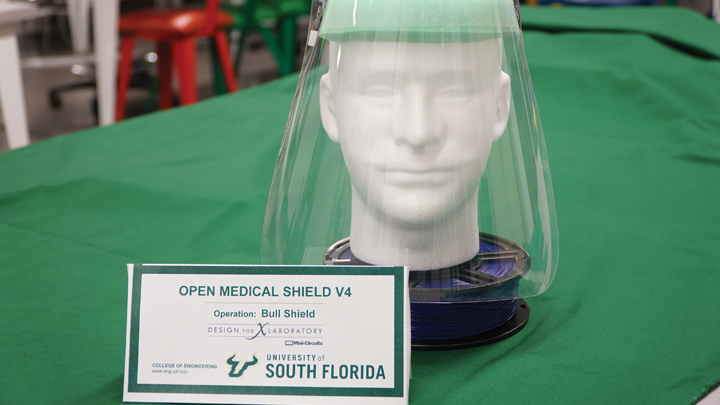Current Features
Engineering Lab Helps Protect Doctors, Nurses
– USF RESPONDS: COVID-19 –

MICHAEL CELESTIN DESCRIBES the USF College of Engineering’s Mini-Circuits Design for X Laboratory as “a maker-space/hacker-space.”
“It is a safe environment for students from all over USF to come, learn, collaborate and share projects and skills,” says Celestin, ’06, MChe ’08, PhD ’13, senior research engineer.
The lab’s high-tech tools, particularly the laser cutters and 3D printers, attract engineering majors and students from other disciplines – in normal times. However, since the onset of the coronavirus pandemic, Celestin and his team have turned the lab into a manufacturing space to assist frontline health care workers.
“There were many minds that independently and simultaneously began thinking about leveraging existing resources around the time that the pandemic started to become big news in the U.S.,” Celestin explains. “At that point, it was no longer a piece of news from another country or something that was distant – it was here and something needed to be done.”
Engineering Dean Robert Bishop reached out to Celestin to ask how they could assist USF Health and Tampa General Hospital, USF’s teaching hospital, as COVID-19 cases began to surge.
“We worked closely with our local medical community and value their feedback,” Celestin says. “What we heard was very clear: Comfortable and disposable face shields that didn’t need to be cleaned or fussed with worked best.”
He also points out that while face shields at best would take one to three hours on a 3D printer, his team can produce one in 49 seconds and for under 49 cents per unit in materials. Those materials include mylar, elastic and foam.
The original face shield design was an open source design from the University of Wisconsin-Madison, which Celestin and his team “modified and improved for throughput, durability and the unique natures of the materials we were able to procure.”
“We re-published the plans as open source in addition to providing insight into the tripping points and challenges for scaling up,” Celestin says. “The difference between making 20 and 200 face shields is quite striking and not what one might expect.”
The lab can manufacture 575 shields per day, and as of mid-May had produced nearly 10,000. All of the units are delivered to USF Emergency Management, which compiles the list of requests and prioritizes distribution based on metrics and need. Celestin says the bulk of the shields have gone to USF Health and Tampa General Hospital, though additional units have been delivered to the USF College of Pharmacy and the USF Police Department on the Tampa and St. Petersburg campuses.
Celestin and his team also have been using 3D printers to manufacture ear reliefs “to alleviate strain and discomfort for those who have to wear face masks – as opposed to face shields – all day.”
He credits the college’s development team with providing necessary funding and help; Alex Saltos, ’17, MS ’19, the manager who assists with optimizing design and scheduling student work times; and “an amazing group” of student assistants who perform the bulk of the assembly work.
“What we’re doing is helpful to nurses and doctors, but they are the real front-line heroes, not my team,” Celestin says. “We’re just trying to protect them.”
Bishop stresses the importance of responding to the community’s needs during the health crisis.
“In practice, the face shields project has made us more connected not only with the health care professional, but with the local community that we serve,” he says. “Engineering is all about helping people.”
- TOM WOOLF | USF News